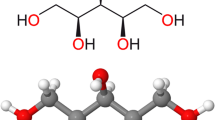Abstract
Exogenously administered zinc compounds have been shown to possess antiulcer activity in the development of gastric lesions. The aim of this study was to investigate the effects of zinc sulphate pretreatment of rats on cysteamine-induced duodenal ulcers and to correlate them with changes in zinc serum and tissue levels. Atomic absorption spectrophotometry was used to determine zinc serum and tissue concentrations in all animal groups. Cysteamine produced marked duodenal ulceration in control animals 24 h after application, with an increase in endogenous zinc tissue concentrations and a marked decrease in serum concentrations. Zinc sulphate (20, 40 or 80 mg kg-1) applied per os one hour prior to cysteamine application inhibited the development of duodenal lesions in a dose-related manner. The application of zinc sulphate in a single intraperitoneal (i.p.) application (80 mg kg-1) did not, however, prevent the formation of duodenal lesions. In order to assess zinc absorption from the gastrointestinal tract, one group of rats received a single oral dose of zinc sulphate (80 mg kg) without cysteamine application. The observations of this study seem to indicate that zinc plays an important cytoprotective role in duodenal ulcer disease.
Similar content being viewed by others
References
Blanusa M, Breski D. 1981 Comparison of dry and wet ashing procedure for cadmium and iron determination in biological material by atomic absorption spectrophotometry. Talanta 28, 681–684.
Bosch F, Jimenez E. 1990 Post-marketing surveillance of zinc acexamate in peptic ulcer treatment. Clin Trials J 27, 301–312.
Brunton LL. 1996 Agents for control and treatment of gastric acidity and treatment of peptic ulcers. In: Hardnen JG, Goodman-Gilman A, Limbird LE, eds. Goodman & Gilman's The Pharmacological Basis of Therapeutics. New York: McGraw-Hill; 901–916.
Cho CH. 1989 Current views of zinc as a gastrohepatic protective agent. Drug Develop Res 17, 185–197.
Cho CH, Ogle CW. 1977 The effects of zinc sulphate on vagal-induced mast cell changes and ulcers in the rat stomach. Eur J Pharmacol 43, 315–322.
Cordova A. 1994 Zinc content in selected tissues in streptozocin-diabetic rats after maximal exercise. Biol Trace Elem Res 42, 209–216.
Eaton DL, Stacey NH, Wong KL, Klaassen CD. 1980 Dose-response effect of various metal ions on rat liver metallothionein, glutathione, heme oxygenase and cytochrome p-450. Toxicol Appl Pharmacol 55, 393–402.
Escolar G, Camarasa J, Navarro C, Vernetta C, Bulbena O. 1987 Antiulcerogenic activity of zinc acexamate in different experimental models. Meth Find Exptl Clin Pharmacol 9, 423–427.
Esplugues JV, Bulbena O, Escolar G, Marti-Bonmati E, Esplugues J. 1985 Effects of zinc acexamate on gastric mucosal resistance factors. Eur J Pharmacol 109, 145–151.
Falchuk KH, Hilt KL, Vallee BL. 1988 Zinc in biological samples by atomic absorption spectrophotometry. Methods Enzymol 158, 422–434.
Frommer DJ. 1975 The healing of gastric ulcers by zinc sulphate. Med J Aust 2, 793–796.
Glavin GB, Szabo S. 1990 Dopamine in gastrointestinal disease. Dig Dis Sci 35, 1153–1161.
Hambidge KM, Casey CE, Krebs NF. 1986 Zinc. In: Mertz W, ed. Trace Elements In Human and Animal Nutrition. London: Academic Press; vol 2, 1–137.
Heilmaier HE, Summer KH. 1985 Metallothionein content and zinc status in various tissues of rats treated with iodoacetic acid and zinc. Arch Toxicol 56, 247–251.
Heilmaier HE, Drasch GA, Kretschmer E, Summer KH. 1987 Metallothionein, cadmium, copper and zinc levels of human and rat tissues. Toxicol Letters 38, 205–211.
Isenberg JL, McQuaid KR, Laine L, Walsh JH. 1995 Acid peptic disorders. In: Yamada T, ed. Textbook of Gastroenterology. Philadelphia: JB Lippincott Co., 1347–1430.
Kashiwagi M, Akimoto H, Goto J, Aoki T. 1995 Analysis of zinc and other elements in rat pancreas, with studies in acute pancreatitis. J Gastroenterol 30, 84–89.
Kotsonis FN, Klaassen CD. 1979 Increase in hepatic metallothionein in rats treated with alkylating agents. Toxicol Appl Pharmacol 51, 19–27.
Lloris JM, Esplugues JV, Sarria B, et al. 1988 Effect of zinc sulphate on gastric mucosal blood flow in gastric emptying in the rat. J Pharm Pharmacol 40, 60–61.
Lorenzo MJV. 1986 Zinc acexamate and ranitidine in the short and mid-term management of gastroduodenal ulcers. Curr Ther Res 39, 19–29.
Momcilovic B, Belonja B, Sham BG. 1975 Effect of the matrix of the standard on results of atomic absorption spectrophotometry of zinc in serum. Clin Chem 21, 588–590.
Navarro C, Escolar G, Banos JE, Casanovas LI, Bulbena O. 1988 Effect of zinc acexamate on gastric mucosal production of prostaglandin E2 in normal and stressed rats. Prost Leucotr Essential Fatty Acids 33, 75–80.
Navarro C, Ramis A, Sendros S, et al. 1990 Relationship between gastric levels and antiulcerogenic activity of zinc. Arch Int Pharmacodyn 307, 119–129.
Ogle CW, Lau HK. 1979 Disodium cromoglycate: its influence on gastric ulcers produced by stress in rats. IRCS Med Sci 7, 393–394.
Onosaka S, Min KS, Fukuhara C, et al. 1986 Concentrations of metallothionein and metals in malignant and nonmalignant tissues in human liver. Toxicology 38, 261–268.
Pfeiffer CJ, Pfeiffer DC, Szabo S. 1987a Early ultrastructural changes in rat duodenal mucosa associated with cysteamine-induced ulcer. Exp Mol Pathol 46, 102–113.
Pfeiffer CJ, Bulbena O, Esplugues JV, et al. 1987b Antiulcer and membrane stabilizing actions of zinc acexamate. Arch Int Pharmacodyn 285, 148–157.
Szabo S. 1978 Animal model of human disease: duodenal ulcer disease. Am I Pathol 93, 273–276.
Szabo S, Cho CH. 1988 From cysteamine to MPTP: structure activity studies with duodenal ulcerogenes. Toxicol Pathol 16, 205–212.
Troskot B, Simicevic VN, Dodig M, et al. 1996 Endogenous zinc concentrations in cysteamine-induced duodenal ulcers in the rat. BioMetals 9, 371–375.
Vallee BL, Falchuk KH. 1993 The biochemical basis of zinc physiology. Physiol Rev 73, 79–118.
Whitehead MW, Thompson RPH, Powell JJ. 1996 Regulation of metal absorption in the gastrointestinal tract. Gut 39, 625–628.
Author information
Authors and Affiliations
Rights and permissions
About this article
Cite this article
Troskot, B., Simicevic, V., Dodig, M. et al. The protective effect of zinc sulphate pretreatment against duodenal ulcers in the rat. Biometals 10, 325–329 (1997). https://doi.org/10.1023/A:1018332618512
Issue Date:
DOI: https://doi.org/10.1023/A:1018332618512




